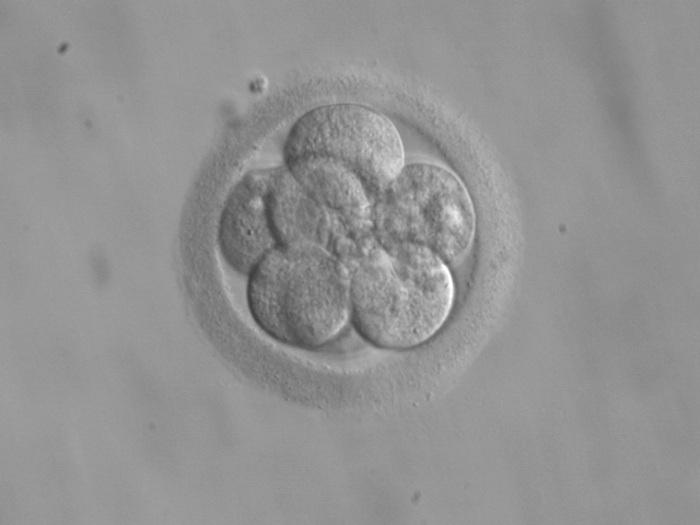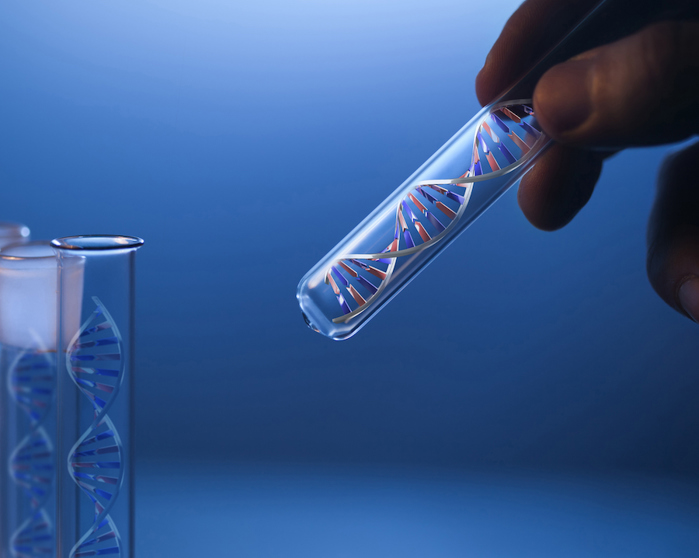
What type of test can be done to determine if you are a chimera?
November 17, 2011

- Related Topics:
- Chimera,
- Rare events,
- Genetic testing,
- Twins
An elementary school teacher from Texas asks:
"What type of test can be done to determine if you are a chimera?"
Most any type of DNA-based paternity test can tell whether or not you are a chimera. But you need a bit of luck too.
Chimeras are really fraternal twins who fused together very early in development. The fusion happens early enough that there aren't any issues with being conjoined or having extra limbs or anything. A chimera is simply a single person made up of cells from two different people.
Sometimes there are outward signs that you might be a chimera. You might have the hair on one side of your head a different color than the other side. Or two different colored eyes. Or stripes that can only be seen under ultraviolet light. (There are also other explanations too.)
Often, though, there are no signs. You might be a chimera and not even know it! Until you get a DNA test that is.
These DNA tests are the only reliable way to tell if you are a chimera or not. Unfortunately, they don't always work. Sometimes you can do all the right DNA tests and still not find out that you are a chimera.

Chimeras Revealed
Chimeras start out as fraternal twins. Two separate eggs fertilized by two separate sperm.
But instead of growing into separate people, the two bunches of cells fuse together and end up as a single person. Nothing bad happens because the cells at this stage are totally undefined. They have the potential to become anything.
So the chimera develops normally. As the embryo grows, some cells become liver, others blood, etc. Which cells have which twins' DNA is totally random.
You could end up with a chimera whose blood has one DNA and whose skin has another. Or one whose blood and skin have the same DNA. Or even a chimera whose blood and skin are both made up of both DNAs.
The same is true for all the different tissues in a chimera's body. We can't predict which cells will have which DNA. And that is what makes interpreting a DNA test so tricky.

DNA Testing of Chimeras
As I said before, each chimera is unique in which cells have one DNA and which have another. This means that to find out if you are a chimera or not, you have to test the right tissues.
For example, if you are a chimera whose blood is made up of cells from both twins, then a DNA test on just your blood would reveal that fact. But if you are a chimera whose blood comes from just one twin, a DNA test on your blood wouldn't be enough. You’d need to test other tissues too.
If you had skin cells from one twin and blood cells from another, then your chimerism might be detected if you tested both types of cells. But if you had skin and blood from one twin and internal organs from another, a DNA test would still miss it. Unless you had reason to dig up a bit of liver or kidney to test.
So if a DNA test comes back that you are not a chimera, you still might be one. You just didn't test the right tissues. A DNA test might find out one person is a chimera and miss this fact with a second person.

Some Possible Results
What I thought I'd do is go now is go over a few possible scenarios in more detail. Before doing this, we need to take a quick step back and go over what a paternity test looks at and what the results look like.
A typical paternity test looks at 12 or 15 different spots on your DNA. These spots have DNA that tends to be different between different people. (Click here to learn more about how they are different.)
Everyone has two sets of these markers, one from your mother and one from your father. So your results at one marker might look like this:
D16S539 9/16
This means that at marker D16S539, you have a 9 from one parent and a 16 from the other. A normal paternity test would have eleven or fourteen more of these markers but I am just going to focus on a single one.
Let's say John is a chimera. Half his blood cells come from one twin and half from another. The results of a DNA test on his blood might look like this:
D16S539 9/16/19/21
He has four different versions of this marker which raises a red flag immediately. Once we've ruled out lab error or contamination, the most likely possibility is chimera.
It is important to note that we would not get such clear cut results at every marker tested. People share some of the same versions of markers, and the more related you are, the more you tend to share.
So it could have been that John had only two versions of this particular marker. But it is very unlikely that he would have only two at all 12 or 15 markers tested. These tests can almost always tell siblings apart and so would detect fused siblings.
Of course, if John's skin is all made up of one twin's DNA and we had only done a cheek swab, then we would miss the fact that he was a chimera. This is why testing multiple tissue samples is so important.
Let's say Jane is a chimera too. All of her skin cells came from one twin and all of her blood cells from another. If we tested just one sample, then we would miss that she was a chimera. But she did the right thing and had both samples tested.
Here are her results:
|
Tissue |
D16S539 Marker |
|
Blood |
9/16 |
|
Cheek swab |
19/21 |
Again once we rule out lab error or contamination, the best explanation is chimera. Because her skin and blood have different DNA, Jane is almost certainly a chimera.
In our final case, let's imagine Sally is a chimera. She has her blood and cheek cells tested and gets this result:
|
Tissue |
D16S539 Marker |
|
Blood |
9/16 |
|
Cheek swab |
9/21 |
So what's up here? Why did we miss the fact that she is a chimera? Well, there are lots of possibilities.
It might be that she happened to have blood and skin from one twin and everything else from the other. Or it might be that 95% of her blood comes from one twin and 5% from the other. A DNA test might miss or disregard such a small percentage.
To find out if Sally is a chimera, we need some other tissue. And those are hard to get to. We may never figure out that she is a chimera.
Sometimes a DNA test can easily show that you are a chimera. A quick cheek swab, a strange result with three or four versions of a specific marker and BAM, you're a chimera.
Sometimes you need to test your blood and your skin cells to find out. You get two different results from each and BAM, you're a chimera.
Sometimes, though, easy DNA tests will miss that you are a chimera. Without digging deep into hard to reach tissues, you'll never know.

Author: Dr. D. Barry Starr
Barry served as The Tech Geneticist from 2002-2018. He founded Ask-a-Geneticist, answered thousands of questions submitted by people from all around the world, and oversaw and edited all articles published during his tenure. AAG is part of the Stanford at The Tech program, which brings Stanford scientists to The Tech to answer questions for this site, as well as to run science activities with visitors at The Tech Interactive in downtown San Jose.
 Skip Navigation
Skip Navigation
